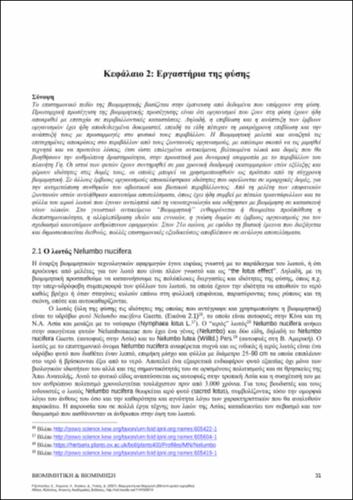Το περιεχόμενο του αποθετηρίου είναι σε διαδικασία ενημέρωσης. Το σύνολο του περιεχομένου θα είναι σύντομα κοντά σας. Ευχαριστούμε για την κατανόηση!
| Title Details: | |
|
Laboratories of nature |
|
| Authors: |
Rhizopoulou, Sophia Chimona, Chrysanthi Koukou, Danae-Ioanna Gkikas, Dimitrios |
| Reviewer: |
Dimoudi, Argyro |
| Description: | |
| Abstract: |
The scientific field of Biomimetics is based on inspiration from data that do exist in nature. A primary approach to the biomimetic approach is that organisms living in nature have already responded successfully to environmental conditions. Thus, the survival and growth of living organisms has already been proven, because living species have achieved long-term survival and development via adaptations to their natural environment. Biomimetics study and search successful responses of living organisms to their habitats, with the ultimate goal of artificially imitating them and proposing solutions; hence, selected objects, improved materials and structures will aid human activity, in the perspective of a dynamic balance with the environment of Earth. Plant tissues have been preserved over a period of millions of years of evolution and possess structural properties that can be used as models by modern biomimetics. In other living organisms, properties linked to hierarchical structures have been were revealed, coinciding with ambient conditions of the abiotic and biotic environment. Innovative results were obtained from the study of living tissues and surfaces, as has already happened with rose petals and leaves of the sacred lotus (Nelumbo nucifera), which were perceived by nanotechnology and led by imitation to the construction of new materials. The subject of Biomimetics is encouraged the interdisciplinarity or interdisciplinary research is considered as a prerequisite for the interaction of ideas and concepts, the knowledge of structures in living organisms and the design of innovative human applications. In the 21st century, the international basic research and publications linked to many scientific specializations aim the improvement of biomimetic results.
Biomimetics is the inspiration and the driving force for numerous investigations linked to the structure and function of organisms, both at the cellular and organismic level and interactions with the environment (biotic and abiotic). All these have been studied by scientific methodology i.e., samples from the living matter of nature were transferred to research laboratories; this was the beginning. Then interdisciplinary research, infrastructures and applications, especially with the contribution of material science, promoted biomimetics by revealing and experimentally controlling the application of properties that have been found to exist in certain living organisms. By observing structures and functions of living organisms (described in previous chapters), many international researchers were able to develop innovative materials that mimic the properties of biological, living organisms in nature. Such constructions require the cooperation of researchers with different scientific disciplines and specializations, who can collectively understand all the theoretical background behind each innovation. In this chapter, some examples of properties and characteristics that exist in living organisms and have gradually led scientific research to biomimetics are presented.
|
| Linguistic Editors: |
Kioseoglou, Nerina |
| Technical Editors: |
Kioseoglou, Nerina |
| Graphic Editors: |
Stragali, Faidra |
| Type: |
Chapter |
| Creation Date: | 22-03-2022 |
| Item Details: | |
| License: |
Attribution - NonCommercial - ShareAlike 4.0 International (CC BY-NC-SA 4.0) |
| Handle | http://hdl.handle.net/11419/8043 |
| Bibliographic Reference: | Rhizopoulou, S., Chimona, C., Koukou, D., & Gkikas, D. (2022). Laboratories of nature [Chapter]. In Rhizopoulou, S., Chimona, C., Koukou, D., & Gkikas, D. 2022. Biomimetics and Biomimesis [Postgraduate textbook]. Kallipos, Open Academic Editions. https://hdl.handle.net/11419/8043 |
| Language: |
Greek |
| Is Part of: |
Biomimetics and Biomimesis |
| Publication Origin: |
Kallipos, Open Academic Editions |

